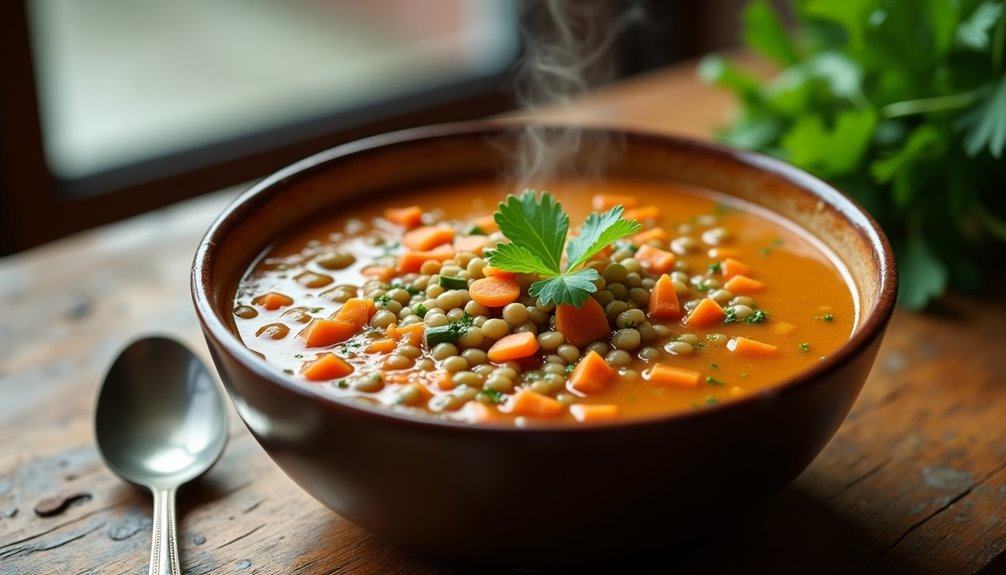Low-sodium lentil soup is a nutritious option that packs in the health benefits of lentils while keeping sodium levels in check. Lentils are rich in protein, vitamins, and fiber, supporting heart health and weight management. By using low-sodium vegetable broth and fresh herbs, you enhance flavor without compromising your health. To make it, sauté onions and garlic, then add lentils and vegetables like carrots. Simmer everything together for a delicious bowl that's easy to customize with spices or leafy greens. If you keep exploring, you'll discover various pairings and tips for storing your delicious soup!
Key Takeaways
- Lentils are rich in protein, fiber, and essential nutrients, making them an excellent base for a low-sodium soup.
- Use low-sodium vegetable broth and fresh herbs to enhance flavor without adding excess salt.
- Customize the soup with vegetables like carrots, celery, and leafy greens for added texture and nutrients.
- Pair the soup with whole-grain bread or a mixed greens salad for a balanced meal.
- Store leftovers in airtight containers and freeze for convenient meal options; defrost overnight for easy reheating.
Health Benefits of Lentils

Lentils are a powerhouse of nutrition, packed with essential vitamins and minerals that can greatly enhance your health. When you incorporate lentils into your diet, you're not just making a flavorful choice; you're also choosing a food that supports your well-being. One of the standout features of lentils is their impressive fiber content. This soluble fiber helps regulate blood sugar levels, promotes digestive health, and can even aid in weight management by keeping you feeling full longer.
Moreover, lentils are an excellent protein source, making them a fantastic option for vegetarians and vegans. They provide about 18 grams of protein per cooked cup, which is comparable to animal-based proteins but with the added benefit of being low in fat. This means you can maintain muscle health and energy levels without the downsides of saturated fats often found in meat.
In addition to fiber and protein, lentils are rich in essential nutrients like iron, folate, and magnesium, all of which play vital roles in overall health. They support heart health, help maintain healthy red blood cell levels, and contribute to stronger bones.
Including lentils in your meals not only adds variety but also connects you with a community that values healthful eating. So, whether you're enjoying a warm bowl of lentil soup or tossing them into a salad, you're making a choice that benefits your health and nourishes your body. Embrace the power of lentils and reap the rewards!
Why Low-Sodium Matters

Maintaining a low-sodium diet is crucial for overall health, especially for heart health and blood pressure management. High sodium intake can result in increased blood pressure, raising the risk of heart disease and stroke. When you opt for low-sodium alternatives, you're not just making a healthier decision for yourself; you're also creating a supportive community that prioritizes well-being.
Integrating salt substitutes can be a game-changer in your pursuit of lower sodium levels. You can experiment with choices like herbs, spices, and vinegar to elevate the taste of your meals without the adverse impacts of excess salt. This approach not only aids in controlling your blood pressure but also sparks innovation in your culinary pursuits.
Instead of feeling limited, you may discover new preferred flavors and pairings, making mealtime pleasurable and captivating.
When you're mindful of sodium, you're actively engaging in a lifestyle that emphasizes heart health. This dedication can motivate those around you to prioritize their own dietary decisions, nurturing a sense of belonging among friends and family who cherish health. You don't have to tackle this journey by yourself; exchange recipes, advice, and experiences with others who are following a similar path.
Ultimately, embracing a low-sodium lifestyle isn't solely a personal decision; it's a stride toward a healthier community. By being deliberate with your food selections, you're seizing control of your health, paving the way for a future filled with energy and connection.
Essential Ingredients for Soup

When crafting a low-sodium lentil soup, choosing the right ingredients can make all the difference in flavor and nutrition. Start with lentils, of course! They're packed with protein, fiber, and essential nutrients. You can opt for green or brown lentils, as both hold their shape well during cooking.
Next, incorporate a variety of vegetables. Carrots, celery, and onions form a classic mirepoix, providing a solid flavor base. You can also experiment with other vegetables like spinach or bell peppers for different flavor variations. Fresh herbs like thyme and parsley will elevate your soup, providing brightness without the need for salt.
For a rich taste, consider using vegetable broth or homemade stock—just be sure to choose essential sodium-free options. If you're feeling adventurous, spices like cumin or paprika can add depth and warmth, enhancing the overall flavor profile without relying on sodium.
Cooking techniques also play a significant role. Sautéing your vegetables before adding liquids can help develop a more robust flavor. Additionally, simmering your soup longer allows the flavors to meld beautifully, creating a comforting dish you'll love to share.
Step-by-Step Recipe

Creating a delicious low-sodium lentil soup is easier than you might think. With simple cooking techniques and a few key ingredients, you can create a comforting meal that's rich in flavor profiles without the excess sodium. Here's a straightforward step-by-step recipe to guide you.
| Step | Action | Tips |
|---|---|---|
| 1 | Rinse and soak lentils | This helps reduce cooking time. |
| 2 | Sauté onions and garlic | Use olive oil for added flavor. |
| 3 | Add vegetables and spices | Carrots, celery, and bay leaves enhance flavor. |
Start by rinsing one cup of lentils under cold water and soaking them for about 30 minutes. While the lentils soak, heat two tablespoons of olive oil in a large pot over medium heat. Sauté one chopped onion and two minced garlic cloves until they're fragrant and golden brown. Then, add one chopped carrot and one chopped celery stalk, cooking for another 5 minutes.
Next, drain the lentils and add them to the pot along with four cups of low-sodium vegetable broth. You can also include herbs like thyme or rosemary to elevate the flavor profiles. Bring everything to a boil, then reduce the heat and let it simmer for about 25-30 minutes, or until the lentils are tender.
Customization Ideas

Customization options for your low-sodium lentil soup can enhance both flavor and nutritional value. You can easily transform this dish to suit your taste and dietary preferences.
Start by incorporating flavorful seasonings like garlic, cumin, or smoked paprika. These spices not only elevate the taste but also provide health benefits, such as anti-inflammatory properties and improved digestion. Don't be afraid to experiment—adding a splash of lemon juice or a dash of hot sauce can create a delightful zing!
Next, think about nutritious additions. Leafy greens, such as kale or spinach, can boost the vitamin content and add a lovely texture. You might also consider including diced tomatoes or bell peppers for a pop of color and extra vitamins.
If you're looking for more protein, throw in some cooked quinoa or shredded chicken. These ingredients contribute to a balanced meal, making it more satisfying.
For a heartier soup, try adding root vegetables like carrots or sweet potatoes. They'll not only enhance the flavor but also provide additional fiber and nutrients. You can also personalize the soup with different types of lentils, such as red or green, to vary the texture.
Storage and Freezing Tips

After you've enjoyed your delicious low-sodium lentil soup—perhaps with some of those tasty customization ideas—it's important to know how to store any leftovers properly. With proper storage, you can enjoy those comforting flavors again, reducing food waste and saving time on busy days.
To store your soup, let it cool to room temperature before transferring it to an airtight container. This prevents condensation from forming, which can lead to spoilage. Be sure to label the container with the date, so you can keep track of freshness. If you're wondering how long it'll last, check out the handy table below:
| Storage Method | Duration |
|---|---|
| Refrigerate (in airtight container) | 3-5 days |
| Freeze (in freezer-safe container) | 3-6 months |
When it comes to freezing techniques, consider portioning your soup into smaller containers. This way, you can easily thaw only what you need. Remember to leave some space at the top of each container, as liquids expand when frozen. To defrost, simply place it in the fridge overnight or microwave it on low power, stirring occasionally.
Pairing Suggestions

Enhancing your meal experience with thoughtful pairings can elevate the enjoyment of your low-sodium lentil soup. To make the most of this nutritious dish, it's crucial to incorporate flavorful additions that complement its earthy taste.
A dollop of Greek yogurt or a sprinkle of fresh herbs like cilantro or parsley can introduce a contrasting element without overwhelming the soup's natural flavors.
If you're looking to round out your meal, whole-grain bread or a side salad can provide a satisfying balance. Choose a mixed greens salad dressed with a light vinaigrette to keep it wholesome and nutritious. These options not only enhance the flavors but also provide necessary nutrients to your meal.
For those with dietary restrictions, it's vital to explore alternatives that still deliver on taste. If dairy is a concern, try avocado slices or a vegan yogurt to add creaminess. You can also experiment with gluten-free bread or crackers, ensuring everyone can enjoy the meal together.
Do not underestimate the significance of beverages, either. Pairing your soup with a light white wine or herbal tea can enhance the overall dining experience. If you prefer non-alcoholic options, a sparkling water with a hint of lemon or lime adds a invigorating touch.
Ultimately, the key is to create a meal that feels inclusive and satisfying for everyone at the table. By carefully choosing your pairings, you're sure to enhance both the flavor and enjoyment of your low-sodium lentil soup.
Frequently Asked Questions
Can I Use Canned Lentils for This Soup Recipe?
Yes, you can definitely use canned lentils for your soup recipe! They offer a convenient alternative to dried lentils, saving you time in lentil preparation. Just rinse them before adding to make certain any excess sodium is washed away.
Canned lentils are ready to use, making them a great choice for busy cooks. Plus, they'll still provide that hearty texture and flavor you love, bringing everyone together around the table.
Enjoy your cooking!
How Long Does Low-Sodium Lentil Soup Last in the Fridge?
Did you know that soups can last about 3 to 5 days in the fridge? When storing your low-sodium lentil soup, make sure it's in an airtight container.
You can enjoy various recipe variations, adding veggies or spices for extra flavor. Plus, lentils offer fantastic health benefits, packed with protein and fiber.
Is This Soup Suitable for a Vegan Diet?
Yes, this soup's perfect for a vegan diet! It offers excellent nutritional benefits, packed with protein and fiber. You'll love its rich flavor profile, making it satisfying and delicious.
If you want to tweak the recipe, consider adding vegetable broth or spices for added depth. You can also make substitutions, like using different legumes or veggies, to suit your taste.
Enjoy creating a dish that not only fits your diet but also brings everyone together!
What Type of Lentils Work Best for This Soup?
When choosing lentils for your soup, consider red, green, brown, or French lentils. Red lentils cook quickly and break down, creating a creamy texture.
Green and brown lentils hold their shape well, adding a hearty bite. French lentils offer a unique flavor and texture.
If you're short on time, canned lentils are a convenient option. Remember to adjust refrigeration time accordingly, especially if you're thinking of adding meat for extra protein in your vegan diet.
Can I Add Meat to Low-Sodium Lentil Soup?
You can definitely add meat to your lentil soup for flavor enhancements. Options like chicken or turkey can complement the dish well, providing additional protein and richness.
However, if you prefer vegetarian alternatives, consider adding mushrooms or tofu, which also offer health benefits. Both choices can enhance the soup's taste while catering to different dietary needs.
Ultimately, it's about what makes you feel satisfied and connected to your meal. Enjoy experimenting!
Conclusion
Incorporating low-sodium lentil soup into your diet not only supports heart health but also offers a wealth of nutrients. Just as a modern smartphone enhances communication, this simple dish boosts your wellness with every spoonful. By making mindful ingredient choices, you can enjoy a comforting meal without compromising on flavor or health. So go ahead, whip up a batch, and savor the benefits—your body and taste buds will thank you!



